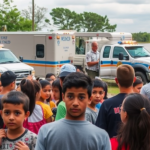**Residents Unprepared as Rio Grande Valley Faces Unforeseen Historic Storms**
Last week, from March 26 to 28, 2025, Texas’ Rio Grande Valley (RGV) faced devastating historic storms that caught the region off guard and resulted in a tragic toll of at least six fatalities. Characterized by unprecedented heavy rainfall and severe weather conditions, the storms have caused significant infrastructure damage across multiple counties, with recovery efforts expected to surpass $100 million, as estimated by the National Weather Service.
**Unexpected and Devastating Nature of the Storms**
The storms delivered nearly 20 inches of rain across the RGV, shattering previous records, including those set by Hurricane Beulah in 1967. Initial forecasts indicated only a moderate amount of rain—one to two inches at most. However, a sudden shift in weather patterns brought unexpected destruction. Rick Saldaña, Emergency Management Coordinator for Hidalgo County, emphasized the surprise factor, “We were predicted to get no more than one to two inches of rain…it took us by surprise.”
Barry Goldsmith, a National Weather Service meteorologist, addressed the forecasting errors, noting the dynamic and complex nature of the storm. “The dynamics of the fast-flowing, high-altitude air currents led to repeated rounds of rainfall…90% of the rain fell over areas unprepared for such volumes.”
**Severe Impact on Community and Infrastructure**
The severe weather resulted in hundreds of Valley residents requiring rescue from flooded homes and stranded vehicles. Additionally, strong winds reaching up to 60 mph were recorded alongside confirmed tornadoes. In the city of Harlingen, heavy rain led to temporary closure of the Valley International Airport due to runway flooding, further complicating recovery efforts.
In the wake of the storm, Governor Greg Abbott issued a disaster declaration for the affected counties, paving the way for federal assistance as FEMA began assessing the damage. Local officials, including Saldaña, were left to ponder enhancements to drainage infrastructure. “We’ve been improving our drainage system since a similar storm in 2018, but this was a ‘100-year flood.’ It overwhelmed what we had,” said Saldaña.
**Agricultural Sector Faces Hard Hits**
Valley farmers, already battling longstanding drought conditions, faced a new adversary in the form of relentless downpours that severely impacted crops and livestock. Texas Agriculture Commissioner Sid Miller lamented the widespread agricultural and livestock losses, stating, “The torrential rains drowned what little hope farmers had for a successful season.”
Even as the Falcon International Reservoir saw a slight rise in water levels due to the storms, increasing from 11.2% to 12.8% capacity, Sonny Hinojosa of Hidalgo County Irrigation District No. 2 stressed that substantial resource improvements are still needed. “We’re still far below what’s necessary to solve our water scarcity issues.”
**Lessons from Past Storms and Future Preparations**
Reflecting on similar instances in 2018, local officials underscore the importance of constant vigilance and robust emergency preparedness strategies. The Valley’s response roadmap includes addressing immediate humanitarian needs while fortifying infrastructure against future weather anomalies.
Rick Saldaña highlighted, “These surprise storms leave little time for planning, compared to hurricanes. But they urge us on continuous improvement, honing our readiness and infrastructure to better protect Valley residents.”
Despite the challenges, the RGV community remains resilient. The collaborative effort between local governments, federal agencies, and community organizations plays a vital role in mobilizing resources and rebuilding what has been lost. Valley residents are encouraged to participate in community discussions, engage with available disaster assistance programs, and utilize information resources provided by county officials.
**Conclusion**
As the Rio Grande Valley faces the aftermath of this historic weather event, local leaders, meteorologists, and community members share a common goal – to use lessons learned to better prepare for future challenges and foster a resilient environment for Valley residents. The RGV’s enduring spirit, coupled with comprehensive support structures, sustains hope for recovery and renewal even in the face of adversity.







